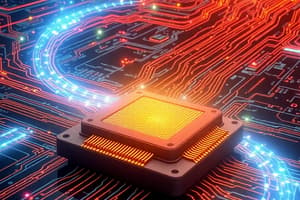Podcast
Questions and Answers
The Program Counter (PC) register indicates the current instruction that has been fetched from RAM.
The Program Counter (PC) register indicates the current instruction that has been fetched from RAM.
False (B)
The Memory Data Register (MDR) stores the instruction that has been transferred from RAM to the CPU.
The Memory Data Register (MDR) stores the instruction that has been transferred from RAM to the CPU.
True (A)
The Fetch - Execute cycle can be performed by the CPU only a few times per second.
The Fetch - Execute cycle can be performed by the CPU only a few times per second.
False (B)
The Accumulator (ACC) register stores the result of mathematical or logical calculations.
The Accumulator (ACC) register stores the result of mathematical or logical calculations.
The Memory Address Register (MAR) is responsible for storing the fetched instruction before it is moved to the Current Instruction Register (CIR).
The Memory Address Register (MAR) is responsible for storing the fetched instruction before it is moved to the Current Instruction Register (CIR).
Flashcards
Register
Register
A small temporary storage space within the CPU used to hold data during processing.
Program Counter (PC)
Program Counter (PC)
Keeps track of the address in RAM of the next instruction to be fetched by the CPU. It's like the CPU's 'to-do list' for the next instruction.
Memory Address Register (MAR)
Memory Address Register (MAR)
Holds the memory address that the CPU wants to access. It helps the CPU fetch instructions from the correct location in RAM.
Memory Data Register (MDR)
Memory Data Register (MDR)
Signup and view all the flashcards
Accumulator (ACC)
Accumulator (ACC)
Signup and view all the flashcards
Study Notes
Fetch-Execute Cycle
- The CPU performs the Fetch-Execute cycle millions of times per second to process data and instructions for programs and services.
- Registers are small storage spaces in the CPU for temporary data, each with a specific role.
Essential Registers in the Fetch-Execute Cycle
- Memory Address Register (MAR): Holds the memory address of the next instruction to be fetched.
- Memory Data Register (MDR): Stores the instruction that's fetched from RAM, and is about to be decoded.
- Current Instruction Register (CIR): Stores the instruction that has been fetched from RAM, ready for decoding and processing.
- Accumulator (ACC): Stores the result of mathematical or logical calculations.
- Program Counter (PC): Shows the address in RAM of the next instruction to be processed. This address is copied to the MAR to fetch the next instruction.
Steps of the Fetch-Execute Cycle
- Fetch: The PC’s value is copied to the MAR. The CPU checks the RAM address in MAR. The instruction in RAM is transferred to the MDR. The instruction in MDR is copied to CIR.
- Decode: The instruction in CIR is understood.
- Execute: The instruction is processed. Any result is stored in the ACC.
- Repeat: The cycle repeats by returning to the first step, checking the PC for the address of the next instruction.
Studying That Suits You
Use AI to generate personalized quizzes and flashcards to suit your learning preferences.
Description
Explore the Fetch-Execute cycle, a fundamental concept in computer science that explains how the CPU processes instructions. This quiz covers essential registers and their roles in fetching and executing instructions. Test your knowledge on how the CPU manages memory and instruction operations effectively.




